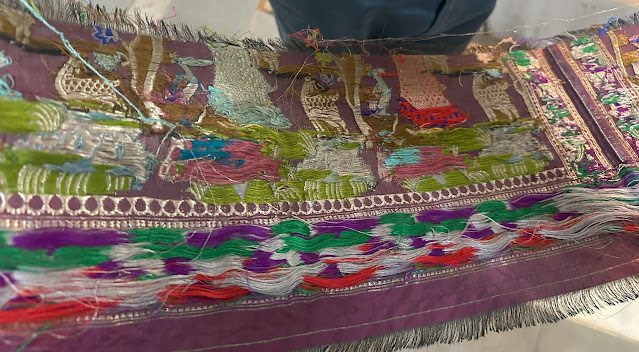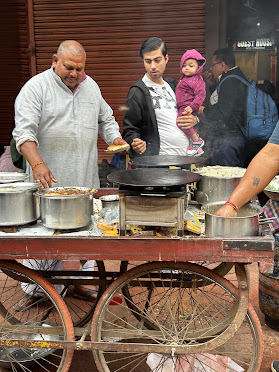December 25, 2024
I love Christmas and all the traditions and food and music that go along with it, and I must confess that I was not all that excited to spend my Christmas Day 2024 in Varanasi looking at cremation sites. I turned out to be quite a day--not the way I want to spend my future Christmases, but good for a one-time experience!
We were picked up at dawn by a new guide and got an early start on our visit to the Ganges to try to beat the crowds. Our driver got as close as he could, and then we walked the rest of the way down a sloping street that led to the river. Clearly, we weren't the only ones who wanted to get an early start.
Women sitting on the sidewalk were selling empty plastic jugs for those who wanted to take some of the holy river's water home with them.


The water's edge was already bustling with locals, pilgrims, and maybe a few foreign tourists like us (but we didn't see them). One of the things that surprised us about India is how few Western tourists we saw.
Judging by how many boats were pulled up to shore, owning a boat looks like a profitable venture here. We even saw one under construction.
I don't think the area had recovered yet from previous busy days. Piles of garbage were stuffed under the overhangs.
We experienced our first ghat, or a flight of stairs leading to a river or wharf. Ghat can also be translated as "bathing place." Varanasi has 88 ghats that serve three basic purposes: cleaning, religious rites such as ritual bathing or ablutions, and cremation. This particular ghat is the Manmahal Ghat. It is quite wide. Here is the right end . . .
. . . and here is the left end:
When we got to the riverbank, we saw boats lined up like sardines in a tin and a bunch of people standing around.
Some people were coming out of the water and some were in the water.

Other spots were even more crowded. This photo is a little grainy, but it gives a good idea of the number of people bathing in the not-so-pristine waters of the sacred Ganges.
Young women walked among the bathers selling flowers for religious rites. Our guide bought some from the girl on the right who was fairly well dressed and busy texting on her cellphone--a collision of two different worlds.
The ghats are best seen from the river, so our guide found us a boat and a rower. With six of us in the boat and the effort of rowing against the current, the man earned every rupee we paid for his services. That's our guide at the back of the boat, wearing a red and blue striped knit cap that reminded me of Waldo and made him easy to pick out in a crowd.
Just a reminder that the AQI was in the 400s, so any lack of sharpness you see in my photos can be blamed on smog.
We started down (up?) the river, and I noticed several of these quaint covered patios where residents and visitors could sit to watch the traffic below.
As you might expect, the riverbanks are overbuilt and I am sure rent is very high. This is Meer Ghat, built in 1735.
Meer Ghat seemed very quiet, and to me it seemed to be a better place for a ritual cleansing.
Next is the recently renovated
Kashi Vishwanath Temple and its adjoining ghat:
Manikarnika Ghat is one of the cremation ghats. The blue walls are there for privacy and there are no stairs, making it easy to transport fuel and bodies between water and land. Dating back to the 5th century, this is one of the oldest and most important ghats in Varanasi.
One of the largest cremation spots on the river, the Manikarnika Ghat is one of the holiest cremation sites in all of India. It is believed that Mata Sati--the first wife of Lord Shiva who was later reborn as the Goddess Pavarti--dropped her earring (known as "Manikarnika") in this spot.
That is a lot of wood, but if you want to keep the fires burning 24/7, you need a lot of wood.
The ghat appears to be quite large and comprises several sections, including these temples.
The partially submerged and leaning structure is the Ratneshwar Mahadev Temple, the Indian version of the Leaning Tower of Pisa. The inner sanctum of the temple is almost always underwater, the only exception being during the dry months of the summer. Hindu priests say it was built 500 years ago, but some records say it is only 200 years old.
Here is a better view of the steps. The red spray-painted lettering on bottom right says "Manikarnika," so I assume this is all part of the same ghat that began with the cremation area.
Moving on, the
Scindia Ghat is another very wide, very open ghat used primarily for bathing.
It has a concrete room on the landing that appears to be a changing room for the women.
The
Ganga Mahal Ghat ("Ganges Palace Ghat") was constructed in 1830 and is known for its beautiful architecture.
I can't figure out which ghat this is, but it is very popular.
The
Munshi Ghat ws built in 1812 and named after one of India's finance ministers.
Next door is the
Darbhanga Ghat, named after a prominent royal family that included major benefactors who helped develop Varanasi's ghats during the 19th and early 20th centuries.
It was time to light our candles. This practice felt like a mixture of making a wish on a birthday candle and lighting a prayer candle in a Catholic cathedral. After lighting our candles and making a wish, we launched them in their little dishes onto the river.
And off they went to join the other 100 million prayers that have been set afloat on the Ganges.
Chausatthi Ghat's red and white stairs make it easy to identify.
Chausath means "sixty-four." No, that's not the number of steps. Rather, it is the number of Hindu deities this ghat is dedicated to.
The lower portion of the
Digpatiya Ghat was built in 1830 by the king of a area in Northern India and is home to several Hindu temples and shrines.
Pandey Ghat, constructed in 1805, is used as a training ground for wrestlers. That's not something I would expect, and I'm not sure how it works.
The
Raja Ghat was built in the 18th century by a king of Varanasi who, according to legends, performed bathing rituals here to cleanse his soul.
The
Mansarovar Ghat is one of the older ghats, built in 1585 by the king of Jaipur. It is named after the sacred Himalayan Lake Mansarovar in Tibet, and it is believed that water from a well at the ghat bears the same sacred powers that the water from Tibet's Lake Mansarovar has.
Another Ghat with red and white steps (so much for easy identification), the
Kshemeshvar Ghat dates to the 19th century and is named after an ancient temple.
It was getting later in the morning, but there were still plenty of people doing their ritual bathing at this ghat.
Kedar Ghat is one of the busiest Ghats on the river. Built in the 18th century, it houses a temple dedicated to Lord Eshwar (aka Shiva).
I love this juxtaposition of modern and ancient. That's India in simplest terms.
We passed by one more cremation site with its piles of wood. I was intrigued by all of the goats at this site, and after I came home I learned that Hindus offer goats as sacrifices to satisfy and appease an assortment of gods and deities or to thank them for various blessings in their lives.


Back on land, we climbed the steps of a Dashashwamedh Ghat, passing by more bathers and an interesting mural.
Dashashwamedh Ghat is the main ghat in Varanasi. Legend has it that Brahma created the ghat to welcome Shiva. The present ghat was built in 1748 and rebuilt in 1774.
Look carefully at the people in this photo and see if you can find any other white tourists like us. Nary a one.

At the top of the steps there is still a lot of action. On the right is one of many platforms where Hindu shamans sit to dispense wisdom and blessings.
So of course we had to have the experience. The Shaman that our guide chose was delightful--friendly, smiling, and able to communicate a little bit in English.
I have wonderful videos of the Shaman blessing us. Unfortunately, I recorded them in a format that can't be uploaded to this blog, but you can watch one of me
here and one of Stan
here. The blessing process is quite complicated.
There was a lot happening at this ghat. Again, so much sound, motion, aromas--quintessential India.
We began to make our way back to our vehicle.
This looked like an interesting place to eat. I wish we had tried it out!
For some reason Bob attracted the attention of these two young boys, and their mother got pretty excited about getting a photo of them and two other children with Bob.
Yeah, all the commotion at the Varanasi ghats IS a little exhausting, but that is a really sad place to take a nap!











































































